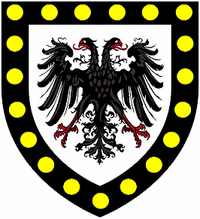William Killigrew (Chamberlain of the Exchequer)

Sir William Killigrew (died 1622) of
Origins
Killigrew was the fifth son of John III Killigrew (died 1567) of Arwenack, Cornwall, the first Governor of Pendennis Castle, situated on land within the Arwenack estate, appointed by King Henry VIII.[2] His mother was Elizabeth Trewinnard, 2nd daughter of James Trewennard of Trewennard,[3] in the parish of St Erth, Cornwall.[4] The monumental brass of John III Killigrew survives in St Budock's Church, near Arwenack.
Career
Under Queen Elizabeth I
In 1571 he was elected Member of Parliament for
Under King James I
He was knighted in 1603 on the succession of King James I. In 1604 he became MP for Liskeard. From 1605 to 1608 he was Chamberlain of the Exchequer. In 1614 he was elected MP for Penryn again.[5]
Marriage and progeny
At some time about 1576 Killigrew married Margaret Saunders, daughter of Thomas Saunders of Uxbridge, Middlesex, and widow of Robert Woolman and of John Leigh. By his wife he had the following progeny:[6]
- Sir Henrietta Maria.
- Elizabeth Killigrew, eldest daughter, wife of Sir Maurice Berkeley (c. 1577–1617), MP,[7] of Bruton Abbey, Somerset.
- Catherine Killigrew (born 1579), wife of Sir Henry Jermyn, 1st Earl of Saint Albans, KG, (1605–1684). Her portrait by Marcus Gheeraerts the Younger (1561–1636) survives in the collection of the Yale Center for British Art, Connecticut, USA.
Landholdings
In 1594 he obtained an 80-year lease of the two adjoining royal manors of Kempton and Hanworth in Middlesex. In 1631 his son Sir Robert Killigrew (1580–1633) secured the reversion and in 1651 the latter's son Sir William Killigrew (1606–1695), "of Kempton Park", conveyed Kempton to John Warburton.[8]
Death and burial
Killigrew died in 1622 and was buried in St. Margaret's Church, Lothbury, in the City of London, near his brother Henry Killigrew.
References
- ^ Vivian, 1887, p.268
- ^ Dunkin, Edwin Hadlow Wise, The Monumental Brasses of Cornwall with Descriptive, Genealogical and Heraldic Notes, 1882, pp.36–7
- ^ Vivian, Lt.Col. J.L., (Ed.) The Visitations of Cornwall: Comprising the Heralds' Visitations of 1530, 1573 & 1620; with additions by J.L. Vivian, Exeter, 1887 [1], p.268
- ^ Tregellas, Walter Hawken (1831–1894), Cornish Worthies, 1884, Vol.2, pp. 115–195, The Killigrews: Diplomatists, Warriors, Courtiers and Poets, p.119
- ^ History of Parliament Online – William Killigrew
- ^ Vivian, 1887, p.270
- History of Parliament biography [2]
- ^ Victoria County History, Volume 3, 1962, Middlesex; Sunbury: Manors[3]
